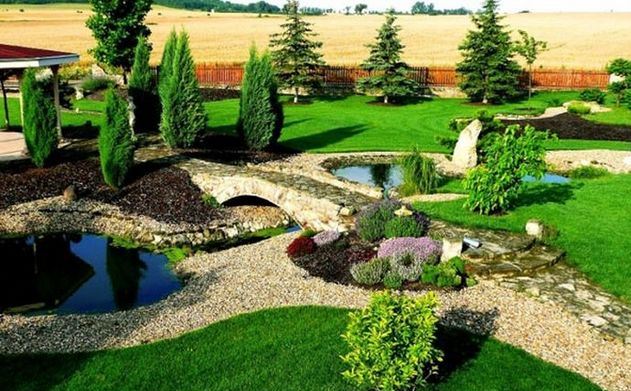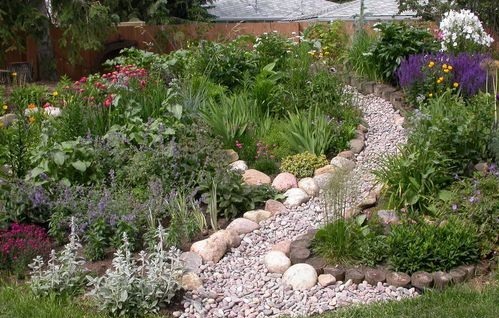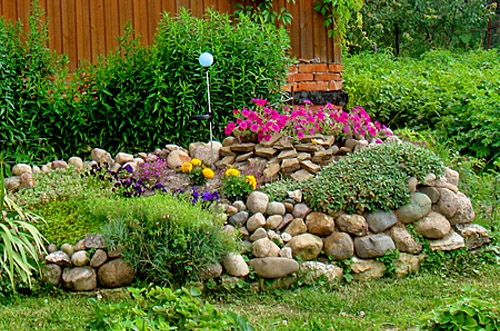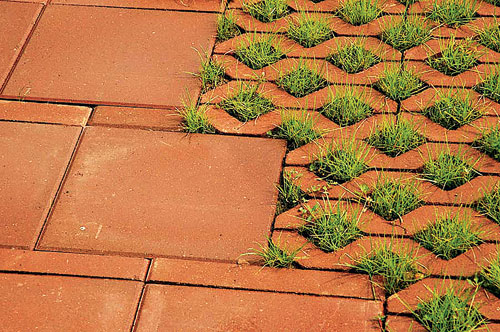In most projects on the design of the landscape, the stone occupies a central place. It is precisely different shapes of cobblestones harmoniously fasten all other elements of the composition into a single whole. Moreover, the current market provides a fairly wide line of types of stones of various origin. To find the right type when planning the landscaping of the site, initially familiarize yourself with the characteristics of the types of stones used in landscape design and recommendations for their preferred use.
Content
Where are the most often used stones?
Given the continuous development of this construction direction, all new forms of design regularly appear regularly.
Therefore, listing all ideas for using stone is impossible, but it is easy to highlight more popular:
- Formation of flower beds, flowers and greenery
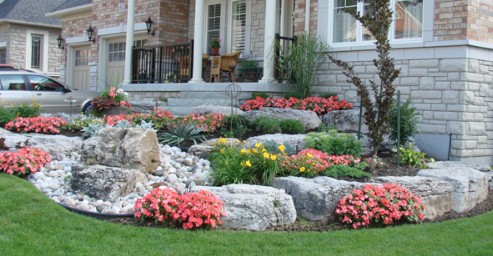
- Preparation of pedestrian paths and roads

- Decorating surfaces of walls of fountains and arbors, fences and exterior walls of the building

- Construction of gardening sculptures

- Arrangement of alpine gorkas

- Creating a Japanese garden and slides from stones in various parts of the site

- Registration of waterfalls and dry streams.

What rocks are used for landscape landscape?
First of all, we note that stones are distinguished for landscape design of natural origin and artificial. In each category there are several species that are most suitable for the conditions of external design in open areas.
Important! The price of a stone for landscape design is primarily determined by its origin, and further dimensions, shape and color.
Natural stones
Among the variety of natural stones, there are several species that apply in their characteristics to design a plot.
The main criteria in this regard are strength to ensure the durability of the application, and the external attractiveness so that the created artificial landscape matches the most appropriately and differ in this unique, unique beauty.
Important! Some species simplify significantly and speed up the process of developing planted plants.
Below is a list of these species with a description of their characteristic features.
- Granite.
 Multicomponent dense stone of magmatic origin, the scope of the application of which is the most extensive. Landscape stone is just one of the options. In its composition there are exclusively natural minerals - mica, quartz, swop. The complexity of the structure affects the color, which is represented by a widely wide palette, which is very valued by designers - black, gray or green base with pink, red, orange nuances, blue. It is worth noting that due to excellent indicators in all technical specifications and external attractiveness, the cost of this stone is also high.
Multicomponent dense stone of magmatic origin, the scope of the application of which is the most extensive. Landscape stone is just one of the options. In its composition there are exclusively natural minerals - mica, quartz, swop. The complexity of the structure affects the color, which is represented by a widely wide palette, which is very valued by designers - black, gray or green base with pink, red, orange nuances, blue. It is worth noting that due to excellent indicators in all technical specifications and external attractiveness, the cost of this stone is also high. 
- Gneiss. In its composition is similar to granite. Among the notable distinctive characteristics, we note the features of its color: shades of light and dark tones are replaced by strips along the entire granules.

- Basalt. This breed is formed when an eruption of a volcano from the streams of lava. Therefore, it is endowed with the same properties of strength, like granite. Different with a porous structure. Available shades - black, smoky gray and black and green.

- Sandstone. A stone of sedimentary origin, the basis of which is a quartzite connected by carbonate. Quite often found in its composition and impurities of iron ore, due to which, in strength, it is only a little inferior to granite. The color palette is represented by shades of white, red, beige, green, brown, blue and gray. The structure can be like layered and fine-grained, depending on the type.

- Slate. It is advantageous to this stone color variety - gray, graphite-black, burgundy, blue, poisonous green, yellow, red - far from a complete list of all possible options.
 In addition, these natural stones in landscape design with splashes and divorces are particularly attractive. A very clear difference has a stone structure due to its metamorphic and sedimentary origin - the layering of thin plates, which can roll out over time.
In addition, these natural stones in landscape design with splashes and divorces are particularly attractive. A very clear difference has a stone structure due to its metamorphic and sedimentary origin - the layering of thin plates, which can roll out over time. 
- Limestone. Another sedimentary breed. Despite its briefness due to light crumbling, bundle and weathered, uses in certain demand in some directions of design of the green zone. The color palette is represented by pale and saturated shades of white and yellow.

- Marble. Mountain breed consisting of crystals. Its base includes limestone and dolomite transformations. According to the degree of strength, it is inferior to similar granite and gneiss, but, nevertheless, is popular. One of its main advantages is colorful coloring. In addition, it is easily processed, due to which there is a possibility how to give any complex geometric shape, and easily polish the surface.

- Porphyry. This stone is distinguished by increased strength characteristics that on the one hand allows it for a long time to use it in any conditions, on the other, it complicates the process of crushing. Its structure is quite interesting - single crystals of larger size stand out against the background of the majority of the entire granule. Color range is represented by different shades of red.

- Tuff. Soft and light porous stone. Among its features, highlight the high absorption of moisture, which the landscape designers are converted into exceptional dignity.

Artificial breeds
Artificial stones also find their use, primarily due to the lower price.
The following types are most in demand:
- Brick. This artificial stone enjoys constant popularity since ancient times. Its rich color and resistance to natural devastating phenomena allow it to be used in landscape construction. There is a variety of great demand as a clinker brick. The technology of its production is distinguished by the final firing, which makes the surface more attractive.

- Concrete. One of the most durable artificial stones. Despite the problem of its unsuitability as a decorative material, it is quite widely used in this area. Especially interesting developments in relation to the color palette, which form at the expense of special additives.

What form of stones is used most often?
Depending on the size of the granules, several types of stones are distinguished:
- Blinds are distinguished by large sizes and acute chip shape.

- Boulders in their parameters correspond to blocks, but have more rounded shapes.

- Cobblestones are distinguished by little smaller parameters and streamlined forms of natural origin.
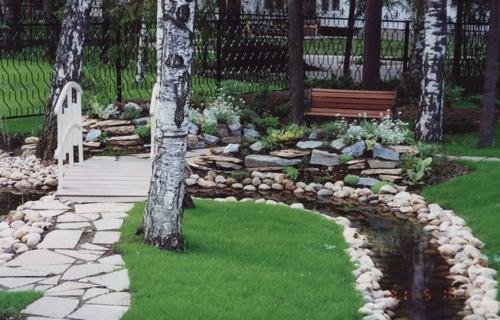
- Crushed stone formed when extracting various ore and soil. Refers to the category of bulk materials. It happens both the cornerstone and more rounded form, which is formed depending on the material of the base and the applied technology of its grinding. The dimensions of the fractions are determined by a completely wide range.

- Pebbles. Subnegous streamlined stones of small sizes. Typically, pebbles are characterized by a combination of several shades.

- Chit. Another name is screening. In essence, it is waste processing, which also find application, for example, in decorating. Baby is all possible stones of natural and artificial origin.

Luminous stones for landscape design
This type of artificial stones will highlight in a separate group, as a novelty of technology. They are applied relatively recently, because of which only occasionally we see lively applying them in our country.
However, glowing stones are one of their most interesting ways to form a landscape, which allows you to enjoy the beautiful view of the landscape plot not only during the daytime, but even in the dark of the night. Fancy placepins invariably attract attention and make a feeling of fabulous and comfort.
Distinguish the following types of stones of this direction:
- Hollow polymer forms with built-in LEDs. Purchase is quite expensive, but with a long (more than 10 years) use for use. In the light of day, such stones look with translucent foreign fragments, so when applied, it should be very neat.

- Plastic stones with catalysts. Simple and affordable service. Energy feeding occurs naturally - from sunlight during the daytime. In addition, they are distinguished by light weight, similarity with natural stones with natural light. It is too easy to care for them: to remove the dust and dirt and mud is enough to wash with running water and add in the natural environment.
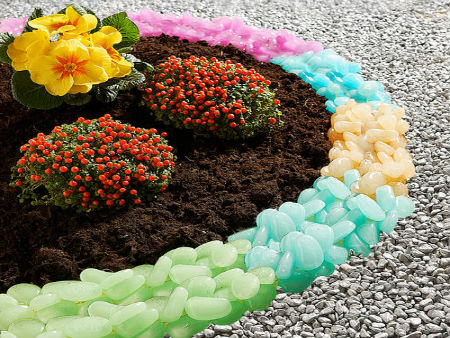
- Natural or artificial stones painted by luminescent paint. This method also uses certain demand. Any stones suitable for the embodiment of the design idea are only covered with a layer of paints, glowing in the dark, and after drying it with varnish to increase the resistance to adverse natural conditions of high humidity and direct sunlight.

Important! It is impossible to accurately determine more sought-after, since each of the types finds its application. The main thing when choosing a suitable complex - navigate the personal artistic taste and correctly relate the size of the stone and the site to avoid absurdness and dissonance composition with the rest of the landscape design elements.
Practical recommendations for choosing stones for decorating the site
For each individual idea in the arrangement of the site, there are a number of recommendations for the selection of materials. They must be taken into account when designing, to buy stones for landscape design with suitable characteristics.
This approach will create strong, sustainable and durable forms. In addition, the rules for compiling tracks are also important for the aesthetic side of the process. Consider attentively photo of stones in landscape design - many ideas are not just unique, but literally catching a look.
Note some of the most popular directions:
Decoration of flower beds, Alpine slide or rocaria
To create an interesting combination with vegetation, the following breeds of stones are recommended:
- slanets
- granite
- sandstone
- limestone.
In relation to the form it is difficult to make any restrictions - only the size of the flower bed will be the main criterion. It looks very impressive as the framing of glowing stones.
Important! When regulating Rokaria, pay special attention to the limestone - it will accelerate the process of expanding the MCH.
What should not be done?
Use too much a variety of rocks of mountain origin. This principle will create the opposite effect, emphasizing the artificiality of the slide or flower beds.
Registration of artificial reservoir
Stressed natural beauty and naturalness such rocks as:
- granite
- slanets
- serpentinite
- river cobblestone.
Only some tips are possible regarding the sizes:
- Sliding boulders and streamlined boulders of large sizes Use as a central accent of the reservoir.
- Oarsdis pebbles or rubble perfect for the design of the bottom.
What should not be done when creating your own reservoir?
Limit the use of dolomite, limestone and marble. Under the influence of water, they are splitting, having a detrimental effect on the composition of the soil, and, accordingly, on planted plants.
Construction of paths in the park-garden zone
For the formation of roads, the use of durable breeds resistant to abrasion is rational.
An excellent option will be:
- basalt
- granite
- porphyry
- slanets
- concrete.

Important! Very unusual and attractive at night, paths with sowing of luminous stones look.
What rocks do not use?
Limit the use of crumbling stones, for example:
- limestone
- sandstone.
They will not stand the load, from which the pavement itself will not only collapse, but also will decrease the attractiveness of the entire landscape.
Registration of lawn
To change the ordinary herbal cover, dilute the look at the hills of their stones or separately worthy blocks. A particularly interesting solution is to lay a mesh clinker brick, before planting grass. She germinates in the groove, creating a rather advantageous impression.
Decorating stairs
This mainly refers to the arrangement of the stamps. For this purpose, both natural and artificial breeds are used:
- granite
- sandstone
- gneiss
- flagstone
- concrete.

Important! The processing process of stacked plates is required to reduce the slip.
Installation of architecture elements
This area includes various forms:
Natural breeds look at the most profitable:
- granite
- limestone
- sandstone
- gneiss
- marble
- concrete.
Video
Browse the video in which the most popular and non-standard solutions for using stone in landscape design.
Conclusion
When designing a landscape, we carefully think over all the details. Previously familiarize yourself with the most popular ways of layouts like plants and stones. The entire process of arrangement of the site does not tolerate rush of the slope. Therefore, we will reinforce the plants planted and carefully install the chosen stones. Only in this case the result will certainly please you.

